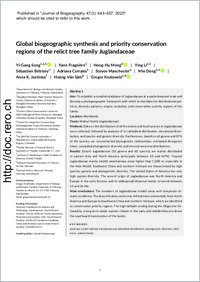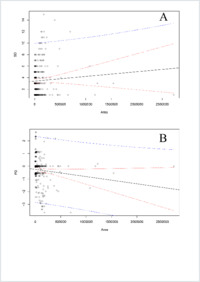Global biogeographic synthesis and priority conservation regions of the relict tree family Juglandaceae
- Song, Yi‐Gang Department of Biology and Botanic Garden University of Fribourg Fribourg Switzerland - Shanghai Chenshan Plant Science Research Centre Chinese Academy of Sciences / Shanghai Chenshan Botanical Garden Shanghai China - Eastern China Conservation Centre for Wild Endangered Plant Resources Shanghai Chenshan Botanical Garden Shanghai China
- Fragnière, Yann Department of Biology and Botanic Garden University of Fribourg Fribourg Switzerland
- Meng, Hong‐Hu Centre for Integrative Conservation Xishuangbanna Tropical Botanical GardenChinese Academy of Sciences Kunming China
- Li, Ying Shanghai Chenshan Plant Science Research Centre Chinese Academy of Sciences / Shanghai Chenshan Botanical Garden Shanghai China - Eastern China Conservation Centre for Wild Endangered Plant Resources Shanghai Chenshan Botanical Garden Shanghai China
- Bétrisey, Sébastien Department of Biology and Botanic Garden University of Fribourg Fribourg Switzerland
- Corrales, Adriana Facultad de Ciencias Naturales y Matemáticas Universidad del Rosario Bogota Colombia
- Manchester, Steven Florida Museum of Natural History University of Florida Gainesville FL USA
- Deng, Min Shanghai Chenshan Plant Science Research Centre Chinese Academy of Sciences / Shanghai Chenshan Botanical Garden Shanghai China - Eastern China Conservation Centre for Wild Endangered Plant Resources Shanghai Chenshan Botanical Garden Shanghai China
- Jasińska, Anna K. Institute of Dendrology Polish Academy of Sciences Kórnik Poland
- Văn Sâm, Hoàng Vietnam National University of Forestry Ha Noi Vietnam
- Kozlowski, Gregor Department of Biology and Botanic Garden University of Fribourg Fribourg Switzerland - Natural History Museum Fribourg Fribourg Switzerland
-
07.01.2020
Published in:
- Journal of Biogeography. - 2020, vol. 47, no. 3, p. 643–657
English
Aim To establish a complete database of Juglandaceae at a spatiotemporal scale and develop a phylogeographic framework with which to elucidate the distributional patterns, diversity patterns, origins, evolution, and conservation priority regions of this family. Location Worldwide. Taxon Walnut family (Juglandaceae). Methods Data on the distribution of all the extant and fossil species of Juglandaceae were collected, followed by analyses of its latitudinal distribution, elevational distribution, and species and generic diversity. Furthermore, based on all genera and 87% of the species, we reconstructed phylogenetic relationships, estimated divergence times, calculated phylogenetic diversity and inferred ancestral distributions. Results Extant Juglandaceae (10 genera and 60 species) are mainly distributed in eastern Asia and North America (principally between 20 and 40°N). Tropical Juglandaceae mainly inhabit mountainous areas higher than 1,000 m, especially in the New World. Southwest China and northern Vietnam are characterized by high species, generic and phylogenetic diversity. The United States of America has only high species diversity. The area of origin of Juglandaceae was North America and Europe in the early Eocene, and its widespread dispersal mainly occurred between 13 and 26 Ma. Main conclusions The members of Juglandaceae inhabit areas with temperate climatic conditions. The diversification centre has shifted intercontinentally from North America and Europe to Southwest China and northern Vietnam, which are identified as conservation priority regions. The high-latitude cooling during the Oligocene followed by a long-term stable warmer climate in the early and middle Miocene drove the southward translocation of the family.
- Faculty
- Faculté des sciences et de médecine
- Department
- Département de Biologie
- Language
-
- English
- Classification
- Biological sciences
- License
-
License undefined
- Identifiers
-
- RERO DOC 328167
- DOI 10.1111/jbi.13766
- Persistent URL
- https://folia.unifr.ch/unifr/documents/308444
Other files
Statistics
Document views: 168
File downloads:
- pdf: 363
- Supplementary material: 237

